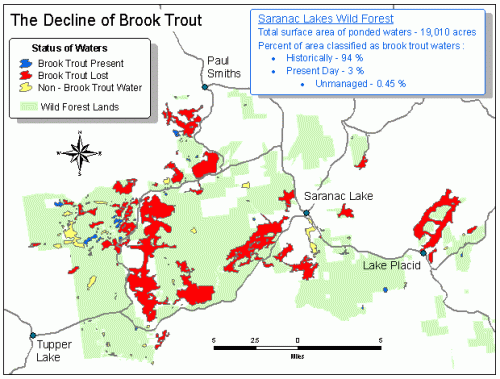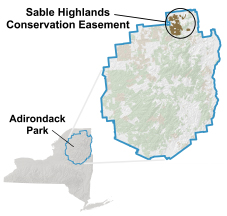 The New York State Department of Environmental Conservation (DEC) recently completed a major effort to eradicate non-native fish from Lower Sargent Pond in Hamilton County, DEC Regional Director Robert Stegemann announced today. The pond will be stocked with fish next year to reestablish the high quality, naturally reproducing native brook trout fishery that had existed there before its population was depleted due to the presence of the non-native fish.
The New York State Department of Environmental Conservation (DEC) recently completed a major effort to eradicate non-native fish from Lower Sargent Pond in Hamilton County, DEC Regional Director Robert Stegemann announced today. The pond will be stocked with fish next year to reestablish the high quality, naturally reproducing native brook trout fishery that had existed there before its population was depleted due to the presence of the non-native fish.
“Native brook trout populations have been significantly reduced in the Adirondacks and other areas throughout the east, but we are committed to restoring these populations in local waters,” said Director Stegemann. “This tremendous coordinated effort will ensure the continued existence of a natural aquatic community and provide a high quality wilderness fishing experience for anglers.”
Providing a high quality wilderness fishing experience on Lower Sargent Pond promotes Governor Cuomo’s NY Open for Hunting and Fishing Initiative, which has improved recreational activities for in-state and out-of-state sportsmen and sportswomen, and boosted tourism opportunities throughout the state. This initiative includes the streamlining of hunting and fishing licensing along with reduced license fees, improved access for fishing at various sites across the state and increased regional hunting and recreational opportunities.
The eradication of non-native fish, followed by restocking with native brook trout is a key component of DEC’s Brook Trout Restoration Program. DEC is a partner in the Eastern Brook Trout Joint Venture (http://easternbrooktrout.org/), which is working to protect, restore and enhance brook trout populations and habitats across their native range.
For decades Lower Sargent Pond was considered a high quality fishery, which sustained natural reproducing brook trout population. It was one of the most popular fly-in fishing destinations in the Adirondacks, and many anglers would walk the two miles into the pond to fish for brook trout.
As the abundance of largemouth bass increased in the pond, the brook trout population severely declined. In 2012, no young brook trout were present; only large, older brook trout that had been hatched before the bass population had grown. The decline in the brook trout population was not due to overfishing. The primary causes were illegal fish stocking and use of bait fish.
The eradication of non-native fish from a water body is known as a “reclamation.” The reclamation procedure is used to return the water to a historic natural aquatic community, provide higher quality fishing opportunities and, where possible, to reintroduce endangered fish species such as round whitefish.
The reclamation of the131-acre Lower Sargent Pond is the largest reclamation in New York State in several decades. A considerable amount of resources and a extensive coordination were needed to complete the reclamation over a five-day period. The effort included the participation of dozens of DEC staff from various regions and programs, and assistance from the State Police Aviation Unit for helicopter transport of personnel, equipment and supplies. There were 37 trips by helicopter during the project, but many workers still had to walk two miles to and from the nearest road carrying equipment and supplies.
Non-native fish, such as bass, yellow perch and golden shiner, negatively impact the native fish communities and ecosystems of Adirondack waters. Non-native fish prey on the eggs and young of native fish. They out compete brook trout and other native fish by consuming large quantities of zooplankton (very small aquatic animals) and other prey food that the native fish feed upon.
It is illegal to move fish from one water body to another without a permit from DEC. The possession or use of fish as bait is prohibited in Lower Sargent Pond and many other trout ponds in the Adirondacks to prevent the introductions of non-native fishes.
Adirondack heritage strain Little Tupper brook trout will be stocked in the pond next year. It is projected that in the next three to five years, Lower Sargent Pond will once again be a high quality wilderness brook trout fishing destination.
Brook trout thrive on a diet of insects and other invertebrates, and grow to large size in ponds that do not have minnows as forage. The current state record brook trout is a 6 pound fish caught in an Adirondack wilderness pond that contains no other fish species. Minnows can become abundant in a pond or lake and compete with brook trout for food – decreasing the brook trout population.
More information on protection of native brook trout, impacts of non-native fish, rotenone and other topics can be found at: Protecting Adirondack Fish.


 David Stilwell of the USFWS said “One of the Service’s goals is to work towards fully functional and sustainable landscapes. This multi-agency effort to reintroduce lake sturgeon to New York rivers brings us one step closer to restoring the natural heritage of New York waterways. We look forward to working together in partnership on future projects in the St. Lawrence River tributaries.”
David Stilwell of the USFWS said “One of the Service’s goals is to work towards fully functional and sustainable landscapes. This multi-agency effort to reintroduce lake sturgeon to New York rivers brings us one step closer to restoring the natural heritage of New York waterways. We look forward to working together in partnership on future projects in the St. Lawrence River tributaries.”




